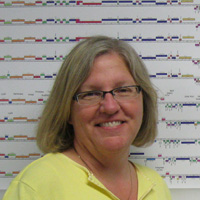Welcome to the forums at seaphages.org. Please feel free to ask any questions related to the SEA-PHAGES program. Any logged-in user may post new topics and reply to existing topics. If you'd like to see a new forum created, please contact us using our form or email us at info@seaphages.org.
Recent Activity
All posts created by debbie
| Link to this post | posted 29 Jul, 2025 17:26 | |
|---|---|
|
|
Thanks Chris! |
Posted in: Cluster AS Annotation Tips → deoxycytidylate deaminase OR nucleoside deoxyribosyltransferase.
| Link to this post | posted 28 Jul, 2025 20:36 | |
|---|---|
|
|
I checked this out and realized I needed to gain some basic (very basic) biochem) to my understanding: Nucleoside Deoxyribosyltransferase (NDT): Function: NDT transfers deoxyribose from one nucleoside to another, effectively swapping bases. Deoxycytidylate Deaminase (DCTD): Function: DCTD specifically deaminates dCMP to dUMP, removing an amine group. My question is what are the residues/domains that could help to differentiate these? Maybe, my question is how do you recognize a deaminase domain vs a transferase domain? just maybe… debbie |
Posted in: Cluster AS Annotation Tips → deoxycytidylate deaminase OR nucleoside deoxyribosyltransferase.
| Link to this post | posted 09 Jul, 2025 13:53 | |
|---|---|
|
|
Julie, Hi. I have no data to help with this one. Best, debbie |
| Link to this post | posted 25 Jun, 2025 14:39 | |
|---|---|
|
|
Ping, I think a titer of any number is sufficient if you have purified the bacteria such that residual phage from somewhere outside of the cell is removed. I would not evaluate this is a vacuum. are the cells homo-immune to that phage infection. Build the evidence and then see what it tells you. We do not have empirical numbers, but you can collect that data. (And then we would for each phage.) Best, debbie |
Posted in: Lysogeny/Immunity → Liquid phage release assay
| Link to this post | posted 13 Jun, 2025 01:42 | |
|---|---|
|
|
Lee, It sounds correct to me! XXXYYYZ is always a winner! debbie |
Posted in: Frameshifts and Introns → TAC Frameshift in BJ and BN
| Link to this post | posted 05 Jun, 2025 05:53 | |
|---|---|
|
|
Fred (and all), We are aware that the GeneMark server is down. An email has been sent to notify the owners that it is down and requesting that it be restarted. debbie |
Posted in: Annotation → GeneMark Server Connection
| Link to this post | posted 28 May, 2025 15:01 | |
|---|---|
|
|
Hi all, So if your file is live in GenBank, it will have the family classification stated there. You ca n use it. We could try to keep up as we enter things into GenBank, but honestly, ICTV can't keep up with us. Best, debbie |
| Link to this post | posted 23 May, 2025 22:23 | |
|---|---|
|
|
Kurt, This could be a bunch of things. My first guess is the actual files that you are comparing. Do the genomes open in DNA Master? It is likely a corrupt file I think. debbie |
Posted in: DNA Master → Genome Comparison
| Link to this post | posted 16 May, 2025 17:51 | |
|---|---|
|
|
Noe, look at line 65 in the approved function list (directly below the crossed out item). that hit is called a nuclease domain in the databases we use, but there is no nuclease function to that sequence. it is now named "ParB N-terminal-like domain" debbie |
Posted in: Cluster C Annotation Tips → ParB-like nuclease domain
| Link to this post | posted 13 May, 2025 15:06 | |
|---|---|
|
|
Chris and Maria, Excellent choices! Only call one. And do not call a wrap round version. debbie |

